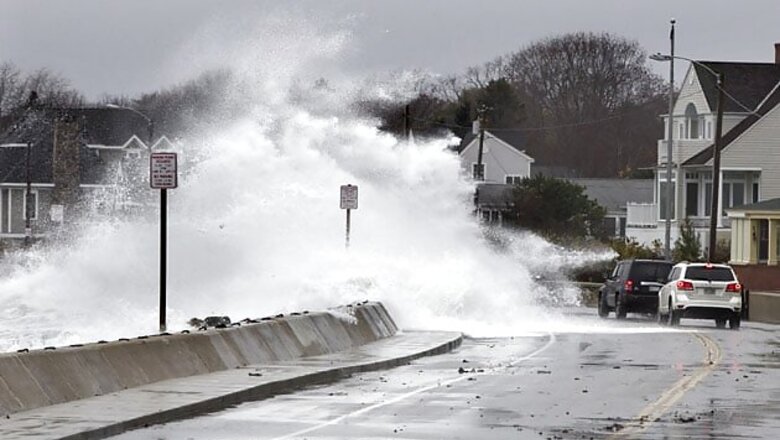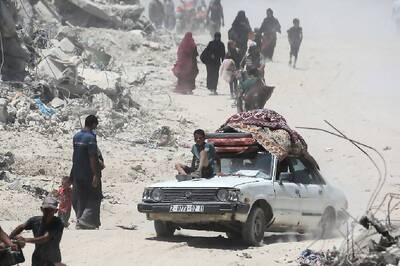
views
Washington: Millions of people awoke to scenes of destruction wrought by Sandy after the powerful storm smashed into the eastern United States, destroying buildings, flooding streets, and cutting power to parts of the nation's most densely populated regions.
Deaths
At least 39 people were reported killed in eight states along the eastern seaboard by Sandy, which dropped just below hurricane status before making landfall on Monday night in New Jersey. Some people were hit by trees, others died in flooding, from electrical shocks or in car crashes linked to the storm. One woman in Toronto was hit by flying debris.
Sandy killed more than 65 people in the Caribbean last week before pounding US coastal areas.
President Barack Obama issued federal emergency decrees for "major disasters" in New York and New Jersey.
People displaced
More than 1 million people in a dozen states along the storm's path were ordered to evacuate, as homes sunk underwater and fierce winds toppled trees.
The Red Cross estimated its shelters housed more than 11,000 people across 16 states. New York City Mayor Michael Bloomberg said the city's shelters housed 6,100 people. The city said shelters would remain open until residents can safely return to their homes.
Power and telecom outages
More than 8.1 million homes and businesses on the East Coast of the United States were without power on Tuesday after the storm tore down power lines, flooded networks, and sparked an explosion at a power station on Manhattan's East River. That compares to 8.4 million outages at the peak of Hurricane Irene last year.
The outages spread from New Jersey, which was hardest hit, to 19 other states from North Carolina to as far inland as Indiana. Power companies estimate parts of New York City could be without power for more than a week.
An additional 145,000 people lost power in the Canadian province of Ontario.
The storm disrupted cellphones, home telephones and Internet services in at least eight states in the northeast.
Flooding, fires
New Jersey was the worst hit. Three towns in New Jersey just west of New York City were inundated with up to 5 feet of water after a levee on the nearby Hackensack River was overtopped or breached. Seaside rail lines washed away, floodwaters forced police and fire departments to relocate their operations, and parts of the coast remained underwater.
In New York City, neighborhoods along the East and Hudson rivers in Manhattan were underwater, as were low-lying streets in Battery Park near Ground Zero, where the World Trade Center once stood. The total area flooded by the storm is still unknown.
The unprecedented flooding hampered efforts to fight a massive fire that destroyed more than 80 homes in the New York City borough of Queens. Mayor Michael Bloomberg said there were at least 23 serious fires across the city.
Transportation
Transportation ground to a halt along the US Northeast coast starting from Monday, stranding local rail commuters, air travelers and cruise passengers from as far away as Europe and Asia, as Sandy prompted closure of air, rail, ship and even highway service. The transport woes also hit cargo operations.
New York closed seven major bridges. New Jersey closed one of its busiest toll roads due to flooding. More than 15,773 flights have been canceled so far as a result of Sandy, according to the flight tracker FlightAware.
A tidal surge paralyzed New York City's subway system, the nation's largest, in the worst disaster to strike it in its 108-year history. The Metropolitan Transportation Authority said it could take up to four or five days to get the water out of the flooded train tunnels.
Mass transit was also shut on Monday and part of Tuesday in Philadelphia and Washington. The Boston public transportation system reopened on Tuesday morning.
Politics
The storm interrupted the presidential campaign a week before Election Day, forcing President Barack Obama and his Republican challenger, Mitt Romney, to cancel appearances. Sandy added a new level of uncertainty to an already tense, tight race for the White House. Obama will stay in Washington on Wednesday after canceling a third campaigning day.
Obama, who has made every effort to show himself staying on top of the storm response, drew praise from Republican New Jersey Governor Chris Christie, who has been a strong Romney supporter. Romney converted what had been intended as a campaign event in Kettering, Ohio, on Tuesday into a "storm relief event." He urged Americans to show generosity in helping the East Coast.
Financial markets
The monster storm closed US stock markets for two days this week, the first time markets had consecutive unplanned closures due to weather since a massive blizzard shut them down in 1888. The unplanned closure on Monday was the first since the September 11, 2001, attacks. Bond markets were also shut on Tuesday. Some analysts estimated banks and trading firms could lose tens of millions of dollars in revenue.
Major US stock exchanges expect to reopen on Wednesday.
The storm delayed several data releases, such as the monthly natural gas report and the weekly Crop Progress report.
Dozens of US companies postponed releasing quarterly results after the storm, and banks closed branches in the Northeast, while promising to waive certain fees in hurricane-threatened areas.
Oil
The second-largest refinery on the US East Coast has suffered flooding and a power outage from Sandy, while two smaller plants also lost power, and glitches threaten to slow the recovery in fuel supplies.
While the region's biggest plant, in Philadelphia, and several others were ramping up operations after escaping damage, other facilities, pipelines and terminals were struggling to restore supplies that had slowed to a trickle.
Economic impact
Sandy appears to have caused more losses than last year's Hurricane Irene, but final totals will be hard to come by for some time because of the scale of the disaster.
One disaster-forecasting company predicted economic losses could ultimately reach $20 billion, only half insured. That would make Sandy the fifth-worst hurricane in history, based on inflation-adjusted losses.
Government, schools
Federal government offices in Washington, which was spared the full force of the storm, were closed for a second day on Tuesday, and schools were shut up and down the East Coast, including New York and Boston.
####Tweets about ”Hurricane Sandy” !function(d,s,id){var js,fjs=d.getElementsByTagName(s)[0];if(!d.getElementById(id)){js=d.createElement(s);js.id=id;js.src="//platform.twitter.com/widgets.js";fjs.parentNode.insertBefore(js,fjs);}}(document,"script","twitter-wjs");




















Comments
0 comment